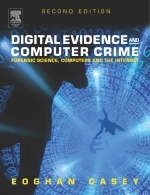
Digital Evidence and Computer Crime
Academic Press Inc (Verlag)
978-0-12-163104-8 (ISBN)
- Titel erscheint in neuer Auflage
- Artikel merken
Digital Evidence and Computer Crime, Second Edition, is a hands-on resource that aims to educate students and professionals in the law enforcement, forensic science, computer security, and legal communities about digital evidence and computer crime. This textbook explains how computers and networks function, how they can be involved in crimes, and how they can be used as a source of evidence.
In addition to gaining a practical understanding of how computers and networks function and how they can be used as evidence of a crime, students will learn about relevant legal issues and will be introduced to deductive criminal profiling, a systematic approach to focusing an investigation and understanding criminal motivations. Readers will receive unlimited access to the author's accompanying website, which contains simulated cases that integrate many of the topics covered in the text.
This text is required reading for anyone involved in computer investigations or computer administration, including computer forensic consultants, law enforcement, computer security professionals, government agencies (IRS, FBI, CIA, Dept. of Justice), fraud examiners, system administrators, and lawyers.
Eoghan Casey is an internationally recognized expert in data breach investigations and information security forensics. He is founding partner of CASEITE.com, and co-manages the Risk Prevention and Response business unit at DFLabs. Over the past decade, he has consulted with many attorneys, agencies, and police departments in the United States, South America, and Europe on a wide range of digital investigations, including fraud, violent crimes, identity theft, and on-line criminal activity. Eoghan has helped organizations investigate and manage security breaches, including network intrusions with international scope. He has delivered expert testimony in civil and criminal cases, and has submitted expert reports and prepared trial exhibits for computer forensic and cyber-crime cases. In addition to his casework and writing the foundational book Digital Evidence and Computer Crime, Eoghan has worked as R&D Team Lead in the Defense Cyber Crime Institute (DCCI) at the Department of Defense Cyber Crime Center (DC3) helping enhance their operational capabilities and develop new techniques and tools. He also teaches graduate students at Johns Hopkins University Information Security Institute and created the Mobile Device Forensics course taught worldwide through the SANS Institute. He has delivered keynotes and taught workshops around the globe on various topics related to data breach investigation, digital forensics and cyber security. Eoghan has performed thousands of forensic acquisitions and examinations, including Windows and UNIX systems, Enterprise servers, smart phones, cell phones, network logs, backup tapes, and database systems. He also has information security experience, as an Information Security Officer at Yale University and in subsequent consulting work. He has performed vulnerability assessments, deployed and maintained intrusion detection systems, firewalls and public key infrastructures, and developed policies, procedures, and educational programs for a variety of organizations. Eoghan has authored advanced technical books in his areas of expertise that are used by practitioners and universities around the world, and he is Editor-in-Chief of Elsevier's International Journal of Digital Investigation.
Part 1 - 1: Digital Evidence and Computer Crime; 2: History and Terminology of Computer Crime Investigation; 3: Technology and Law; 4: The Investigative Process; 5: Investigative Reconstruction; 6: Modus Operandi, Motive & Technology; 7: Digital Evidence in the Courtroom; Part 2 - 8: Computer Basics for Digital Evidence Examiners; 9: Applying Forensic Science to Computers; 10: Forensic Analysis of Windows SystemsChapter 11: Forensic Analysis of Unix Systems; 12: Forensic Analysis of Macintosh Systems; 13: Forensic Analysis of Handheld Devices; Part 3 - 14: Network Basics for Digital Evidence Examiners; 15: Applying Forensic Science to Networks; 16: Digital Evidence on Physical and Data-Link Layers; 17: Digital Evidence on Network and Transport Layers; 18: Digital Evidence on the Internet; Part 4 - 19: Investigating Computer Intrusions; 20: Sex Offenders on the Internet; 21: Investigating Cyberstalking; 22: Digital Evidence as Alibi
| Erscheint lt. Verlag | 23.2.2004 |
|---|---|
| Verlagsort | San Diego |
| Sprache | englisch |
| Maße | 189 x 246 mm |
| Gewicht | 1284 g |
| Themenwelt | Informatik ► Netzwerke ► Sicherheit / Firewall |
| Recht / Steuern ► Strafrecht | |
| ISBN-10 | 0-12-163104-4 / 0121631044 |
| ISBN-13 | 978-0-12-163104-8 / 9780121631048 |
| Zustand | Neuware |
| Informationen gemäß Produktsicherheitsverordnung (GPSR) | |
| Haben Sie eine Frage zum Produkt? |
aus dem Bereich



